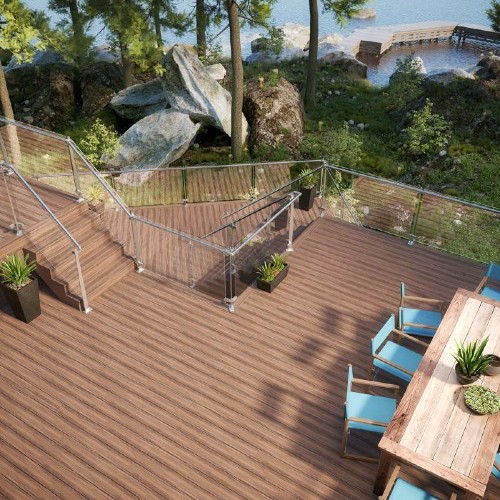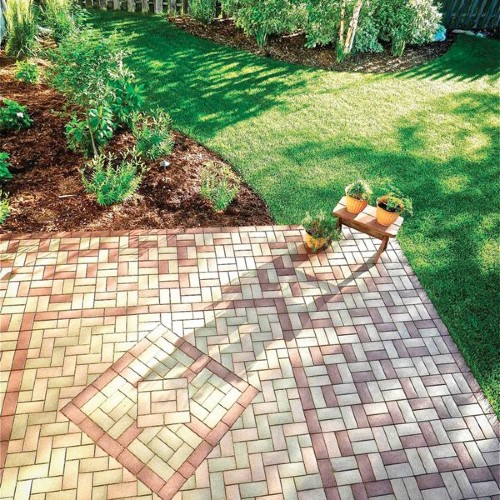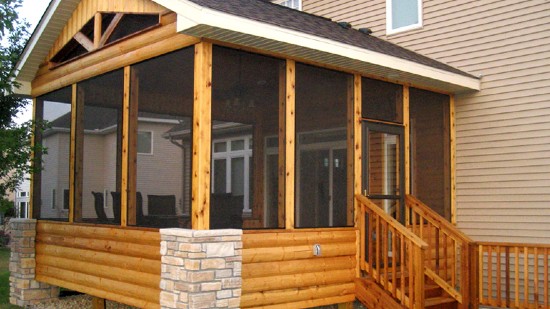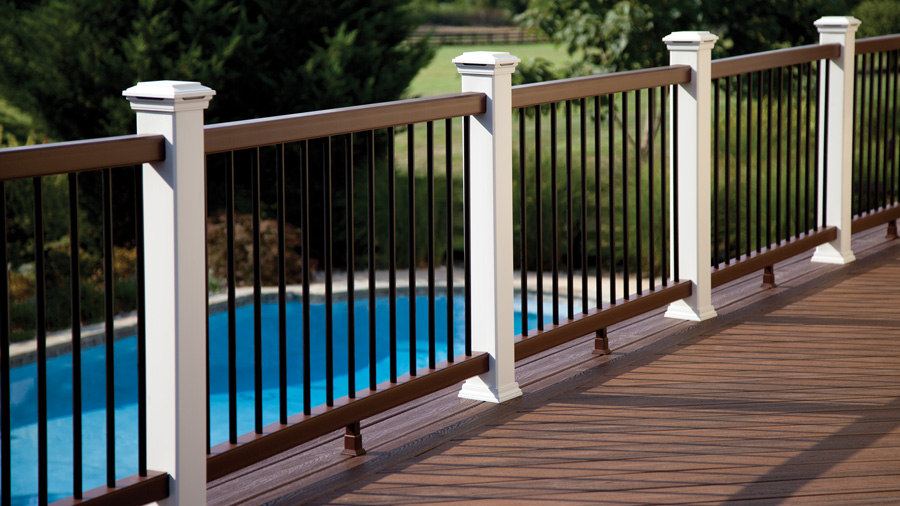DECK VS PATIO VS PORCH
Whether you’re buying a home, adding a new outdoor living space or renovating the space you have, it’s important to know the common terms for outdoor living spaces. Knowing the differences between a porch, a deck and a patio will help you browse for more accurate inspiration, research more focused options and communicate better with realtors and contractors.
So, porch vs patio vs deck - what's the difference? Though decks, patios and porches can come in all shapes and sizes, decks are typically raised, off-ground platforms, while patios are ground-level living spaces. Porches, meanwhile, are covered structures. We’ll run through a few more defining characteristics of each category below.
What's the Difference Between a Porch and a Deck and a Patio?
Decks, porches and patios each have their own unique advantages. To get the best outdoor living possible, it’s important to zero in on your own top priorities to pick the perfect type of space for your lifestyle.
Let’s run through the differences between a porch, a deck and a patio so you can focus your search on the outdoor living space that best suits your vision and needs:
What is a Deck?
Decks are off-ground platforms that are built up above the ground. That doesn’t mean every deck is a full story off the ground, though. Decks can range from just inches off the ground to a structure high enough to require an entry staircase. When a deck is raised more than 3 feet off of ground level, building codes require a deck railing system.
Decks can be built in a home’s front yard, backyard, or side yard. Decks can wrap around a home, or be a free-standing structure not attached to a house. Whether they attach to your home or not, decks are generally considered to be an addition to a house, not a core part of the house’s architecture or design.
What Are Decks Made Of?
To raise a deck up off the ground, builders typically use either an inexpensive wood like treated pine or a metal framing system like Fortress Evolution Steel Deck Framing.
The deck surface sits on top of the framing. Many older decks are made of wood boards, though more builders are turning to more durable composite deck board and PVC deck board options.
Benefits of Decks
With decks, you get advantages like:
- More height means better views
- Can be built on uneven ground
- Higher resale value than patios
By virtue of their raised height, decks typically offer better views than patios. The height does typically come with requirements, though. You’ll usually need to obtain building permits to create a new deck, and it’s important to inspect and maintain your deck’s structure to make sure it remains safe. (This is where metal framing and composite decking can be a lifesaver, cutting down on your regular maintenance while still allowing you to reap the superior view of a deck).
What's the difference between a deck and a patio? Unlike patios, decks don’t require a space with level ground - deck framing can be built on all sorts of uneven surfaces.
Another difference between a patio and a deck is the cost. Decks require a bigger initial investment of time and money than patios, but they also provide much bigger financial returns. Homes with decks generally have higher resale values than decks with patios.
What is a Patio?
Patios are ground-floor outdoor seating areas that can take nearly any shape, design, or layout. Backyard patios can be covered or uncovered, connected to a house or free-standing, and made out of essentially any flooring and landscaping material imaginable.
What Are Patios Made of?
You can build a patio out of a wide range of materials, including wood deck tiles, bricks, or concrete. One durable, low-maintenance option growing in popularity is composite deck pavers. Some deck pavers, like Aspire Pavers, come with a dimpled installation grid for easy installation and to keep pavers from sliding out of place.
Benefits of Patios
Patio benefits include:
- More privacy
- Typically don’t require building permits
- Lower cost and relatively easy to build
Remaining at ground level, patios tend to exchange a deck’s spectacular views for a more private living space, especially in a fenced-in yard. The difference between a patio and a porch is that a patio isn't considered part of the house.
Patios are a cost-effective outdoor gathering space, and usually don’t require building permits - though you’ll want to check with your city, county or municipality to make sure you’re in the clear before you start a project.
While a patio doesn’t require a railing, you can upgrade your patio with screen systems, railing, or privacy walls. Fun fact: A patio is considered a courtyard if it’s surrounded by walls.
What is a Porch?
A porch is a covered structure that is attached to a house, usually through the front or back door. Porches can be open-air with columns or posts supporting the corners, or they can be enclosed, usually with screens or glass.
The difference between a porch and a patio and between a deck and a porch is substantial. Unlike patios and decks, porches are part of a house’s architecture; usually, they share a roof with the rest of the house rather than being a separate addition.
Depending on a home’s layout, a porch can be level with the ground like a patio or raised off the ground like a deck.
Benefits of Porches
- Protection from weather and potentially insects
- Privacy
With a covering - typically an extension of your home’s roof - a porch provides good protection from the elements, including sun and rain. If it’s screened-in, a porch also keeps out insects like mosquitoes.
Even if it’s raised some off the ground, a porch provides a definite feeling of privacy - it’s closer to an indoor living space than a deck or a patio. That’s only amplified if your porch is screened-in or surrounded by glass windows.
With rain protection overhead, a porch also opens up your space to a wider range of outdoor furniture - though you’ll still want to have a dry space to store things like cushions and pillows while you’re not using them.
Porch vs Patio vs Deck: A Cost Comparison
When deciding between a porch, patio, or deck, cost is often a major factor. While all three create valuable outdoor living spaces, they come with different price points based on materials, labor, and maintenance. Below is a breakdown of what you can expect to spend on each option.
1. Material & Installation Costs
The biggest cost drivers are materials and installation complexity.
Porches are the most expensive due to the need for a roof, posts, and sometimes screens or walls. Enclosed porches with windows or HVAC will push costs even higher.
Patios are often the most budget-friendly since they don’t require framing, footings, or railings. However, costs rise if you opt for high-end materials like stone or stamped concrete.
Decks fall in the middle - pricing depends on the size, height, and materials used. Elevated decks require footings, framing, and railing, increasing installation costs.
2. Labor Costs & Complexity
Beyond materials, labor and installation add to the final price.
Porches require skilled labor, including roofing specialists and sometimes electricians if you want lighting or fans installed.
Patios are easier and faster to install, but excavation or grading may be needed if the ground isn’t level.
Decks require carpentry skills, especially if you’re using composite materials that need hidden fasteners or custom railing systems.
Labor costs will vary based on location, contractor rates, and project difficulty, but expect porches and decks to require more hands-on work than a patio.
3. Maintenance & Long-Term Costs
The upfront cost is only part of the equation - each option has different long-term maintenance needs:
Patios are the lowest maintenance, but weeds can grow between pavers, and concrete may crack over time.
Decks require upkeep, especially if using natural wood (which needs staining and sealing every few years). Composite decking has virtually no maintenance costs, requiring just an occasional cleaning.
Porches need regular cleaning, and wooden porches may require repainting or resealing. If enclosed, HVAC, windows, and screens add to maintenance costs.
Which Option Fits Your Budget?
If cost is your main concern, a patio is the most budget-friendly choice.
If you want a balance of affordability and resale value, a deck offers a good middle ground.
If you want a year-round, covered space, a porch is worth the investment but requires a higher budget.
By considering upfront costs, maintenance, and long-term value, you can choose the outdoor space that fits your budget and lifestyle.
Choosing the Right Outdoor Space for Your Home
Whether you envision a cozy porch, a sleek patio, or a versatile deck, each option offers unique benefits based on your budget, home style, and how you plan to use the space. A porch provides shelter and charm, a patio offers a low-maintenance and budget-friendly outdoor area, and a deck creates the perfect elevated spot for entertaining.
Still unsure which option is right for you? Our team is here to help! Give us a call at 1-888-824-5316.
Frequently Asked Questions About Composite Decking Prices
The $4.1 billion North American deck market can be confusing, but DecksDirect has the information you're looking for. Here are some common questions we receive.
Why do some composite decking brands cost more than others?
Higher-end composite decking brands offer more durable materials, better color retention, and deeper wood grain textures. Capped composite and PVC decking tend to be more expensive because they resist stains, moisture, and fading better than budget-friendly options. Some brands also offer longer warranties, which can add to the price.
Can I save money by installing composite decking myself?
Yes! If you're comfortable with DIY projects, installing composite decking yourself can save thousands in labor costs. However, professional installation ensures proper spacing, secure fastening, and a smooth finish. If your deck design is complex or elevated, hiring a pro might be worth the extra expense.
Does composite decking increase home value?
Yes! Composite decking adds curb appeal and is a major selling point for homebuyers looking for a low-maintenance outdoor space. While it may not recoup 100% of the investment, it can significantly boost property value and attract buyers who appreciate long-lasting, high-quality materials.
Knowledge Center
Tips and tricks on deck building and designing from the experts here at DecksDirect!







